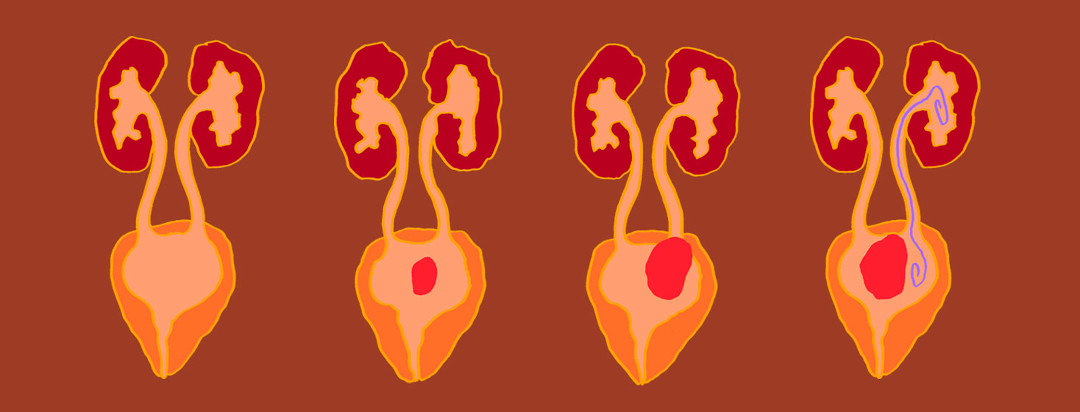Bladder Cancer and Ureteral Stents: What You Need to Know
Our bodies are made up of billions of cells. When these cells grow and multiply too fast, they can cause cancer. Cancer can develop in any part of the body, and when cells grow and clump together to form cancerous tumors in the bladder, a person is diagnosed with bladder cancer.1 Tumors can become so big that they cause problems in your urinary system.2 One problem that can happen is that the tumors in the bladder cancer block off certain pathways that allow you to urinate. If this happens, ureteral stents are placed in your body by a doctor to help you pass urine.
Urinary basics
When you eat or drink, your body keeps the nutrients and gets rid of the waste. One way to get rid of waste is by urinating. The urine goes from your kidneys down to your bladder through tiny tubes called ureters.3 Most people have 2 kidneys and 2 ureters. Once urine gets to the bladder, it leaves your body by passing through another tube called the urethra.3
See a diagram and more explanation about the anatomy of the urinary system here.
What is a ureteral stent?
A stent is a hollow tube put in the body by a doctor. A ureteral stent holds the ureter open so urine can flow through. 4 Stents are flexible and can be different lengths. They span from the bladder to the kidney. Most are about 8 to 10 inches which is a little longer than a pencil. 5
Why would I need a ureteral stent?
Bladder tumors can press against a ureter and close it off. 2 If this happens, you may not be able to urinate, which is a serious problem. If you do not urinate, your kidneys can stop working and make you very sick. 6 A ureteral stent can open up the ureter so urine can flow through. Ureteral stents are also used to treat kidney stones and to help you urinate if your ureter or kidney is damaged.7 Many doctors will also place a stent if they perform a surgery near the ureter.5
Types of ureteral stents
There are a few options your doctor could use to help you urinate. 6 These are:
- Double J Stent – the most common stent. It has curly ends that stick into the kidney and bladder to keep it in place. It is made of polymers like silicone. Sometimes your doctor will place 2 of these side-by-side. This is called tandem stenting.
- Metal stent – there are different types of metal stents, like Resonance, Memokath, and UVENTA stents. Each of the 3 have different shapes and are made of different metals.
- Nephrostomy tube – a tube sticking into the kidney. Urine drains into a bag on the outside of your body. This may be an option if ureteral stents cannot be used.
- Extra-anatomic stent – this replaces the ureter. This is usually used when all other stents fail.
Placing the stent using a cystoscope
You will need to have a small procedure to have a stent placed in your body. A doctor will use a small camera called a cystoscope. This camera goes up your urethra into the bladder. The doctor finds the ureter and passes the stent through the camera. To remove the stent, a doctor will again use the cystoscope. Removing a stent is another small procedure. 8
How long does it stay in my body?
This depends on why the stent was placed and what type of stent was used. Your doctor may recommend a stent for as little as a few days or for 6 months or longer. If you need a stent for several months, it may have to be replaced. Double J stents last 3-6 months, but metal stents are usually used for longer. Nephrostomy tubes and extra-anatomic stents may be more permanent. 6
Do ureteral stents hurt?
Stents can be uncomfortable. About 4 out of every 5 people with a stent have one or more side effects.5 If you experience any of these symptoms or side effects, be sure to let your doctor know so that he or she can help. Common side effects include:
- Frequency - urinating all the time
- Urgency – feeling like you have to urinate often
- Dysuria – a burning feeling when urinating
- Hematuria – blood in the urine, this could be caused by putting in the stent
- Pain – hurting near the kidney or when moving
- Bladder spasms – pain in the bladder
- Urinary tract infections – bacterial infection in the urinary system; antibiotics are used to treat it
Many people with ureteral stents say their symptoms stopped when the stent was taken out.5
How can I prepare?
Not all people with bladder cancer need stents. Tumors grow in different places in the bladder. They are also different sizes and stages. It is possible the cancer may not be close to a ureter. If your doctor says you need a ureteral stent, it is likely for a good reason. Your doctor will consider your age, how healthy you are, and what stage of cancer you have to make a treatment plan that is best. Learning about ureteral stents and talking to your doctor are good ways to prepare.

Join the conversation